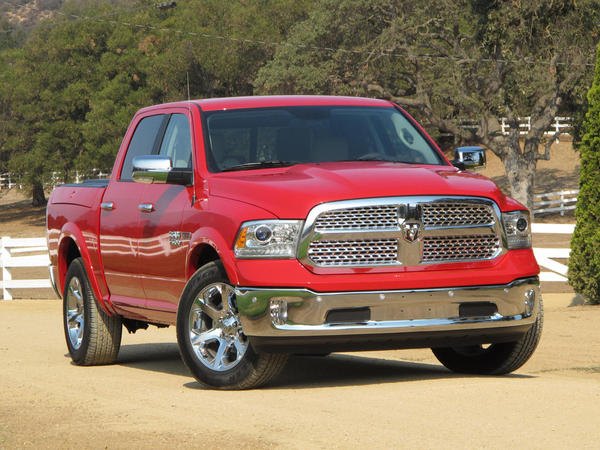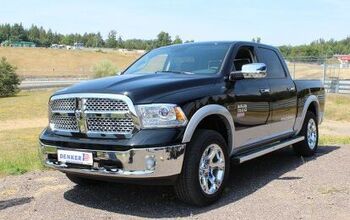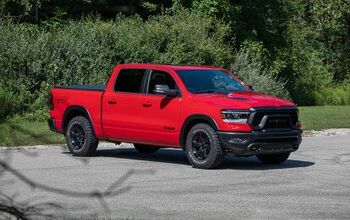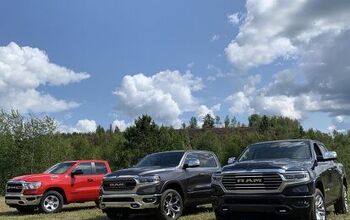Capsule Review: Ram 1500 EcoDiesel
The most important year for the American pickup truck might have been 1996. Although the tenth generation Ford F-Series would debut that same year, the biggest development for the segment had nothing to do with trucks. It was the death of the General Motors B-Body sedan.
A perennial best-seller in America through the 1970s, the B-Body’s demise left American consumers with only one choice for a traditional full-size sedan, the Ford Panther cars. Conventional wisdom states that SUVs subsequently picked up the slack as America’s family hauler of choice, but there’s a case to be made that it was the half-ton crew cab pickup truck that truly replaced the large sedan as America’s family hauler. From 2002 onward, domestic full-size SUV sales began to trend downward, as pick-up sales, well, picked up.
The crew cab era began in earnest right around that time, with the Ford F-150 SuperCrew and a subsequent GM crew cab trucks debuting in 2002. Over a decade later, and both GM and Chrysler have replaced the rear-hinged doors on their extended cab models with a shorter crew cab model, supplemented with even bigger crew cab models that feature massive rear doors.
Shortly before we were invited to test out the Ram 1500 EcoDiesel CrewCab (the bigger of the two 4-doors in Ram nomenclature, with QuadCab being smaller) shown above, TTAC was loaned another Ram 1500 CrewCab – a Pentastar V6 Outdoorsman model, which featured the 8.4″ UConnect system, the lockable Ram Box storage system and a rather spartan interior with drab hard plastics and cloth upholstery (appropriate given the nature of the truck, but a little surprising given the $46,000 pricetag).
The timing of the Outdoorsman test coincided with a reunion for the summer camp I attended as a youth. Located roughly 200 miles from Toronto, the route to the camp is largely composed of rural two-lane highways with some decent grades and winding roads – a good place to put the Pentastar V6 and the new 8-speed automatic to the test.
With its enormous interior space, the CrewCab Ram acquitted itself well with my passengers, all of whom were over 6’2″. No sedan could possibly give them this much space to stretch out, not even the legendary Town Car Signature L. The air suspension provided an effortlessly smooth ride along the less-than-perfect stretches of pavement we traversed. But the Pentastar V6, as refined as it may have been, was a little lacking in power, especially when passing on two-lane highways. Some leeway has to be granted, on account of the Ram hauling a combined weight of 840 pounds of human cargo, plus the associated detritus, but the Pentastar’s power delivery wasn’t quite effortless. Last time we traversed these roads, we had used a friend’s Sierra 2500HD with a 6.6L Duramax diesel, and I found myself wishing for that kind of turbocharged torque that one can find in a diesel or an Ecoboost Ford.
Two months and 2547 miles later and I’m staring face to face with Mopar’s answer for how to get some real grunt without sacrificing on the green front. The Ram EcoDiesel is indistinguishable from the regular Ram, save for the fender mounted emblem shown above. Under the hood is a 3.0L V6 made by VM Motori. Originally planned for the Cadillac CTS, the diesel engine puts out 240 horsepower (43 less than the Pentastar V6) and 430 lb-ft (20 more than the 5.7L Hemi V8). Drawing comparisons to a Cadillac might be a bit of a stretch, but the V6 oil burner is incredibly refined. There is very little clatter at start-up or at idle, and the traditional diesel noises are largely kept in check. One noteworthy change is the addition of a Diesel Exhaust Fluid gauge in the cabin. DEF is used as part of the emissions control package, and the fluid is meant to be replenished at 10,000 miles (the same interval as the engine’s oil). However, regulations require that the engine must be disabled when the DEF supply is exhausted, so keeping an eye on its levels is essential.
Most of the seat time in the diesel Ram came in the form of various stop-and-go scenarios as part of the city driving loops, with the diesel returning a very impressive 24 mpg according to the vehicle’s trip computer. While the Pentastar V6 is said to add about a second and a half compared to the Pentastar Ram’s 7.5 second 0-60 time, the diesel felt much stronger, with plenty of torque available throughout the rev range. Merging and passing was a cinch, with the feel resembling that of a boosted gasoline engine. In a blind taste test, nobody would confuse the Pentastar, the Hemi or the diesel, but the oil-burner’s overall feel is closer to that of the Ford EcoBoost V6 than a traditional heavy-duty diesel engine. Although towing wasn’t a part of my drive, Ram claims that the diesel can haul up to 9,200 lbs with the right equipment.
The biggest sticking point for the diesel is likely the amount of time it will take to break even on the $4,500 premium the diesel commands. Based on a national average prices of $3.62 for gasoline and $3.97 for diesel, the payback over the Pentastar V6 will take decades. When the diesel is put up against the Hemi, the proposition makes more sense, taking about 5 years to pay off.
Nevertheless, rationality doesn’t always play in to these kind of purchasing decisions, as evidenced by the legions of buyers who frequently opt for fuel-efficient vehicles that in reality take lots of time to provide any kind of ROI. The notion of a diesel half-ton pickup will likely prove alluring for many in terms of curb appeal, and the powertrain’s combination of brawn and refinement will win buyers over on the dealer test drive. Otherwise, there’s very little to distinguish the diesel from gasoline powered Ram 1500s. And that’s hardly a bad thing.
Ironically, Ram wasn’t even supposed to be the first one to market with a diesel. At the end of the last decade, Ford reportedly shelved a 4.8L twin-turbo diesel V8, fearing that it would steal sales away from the Super Duty trucks. They won’t be the second one either, since Nissan will release a half-ton diesel Titan within the next year or two. It appears that in this marketplace, the Super Duty trucks are gravitating towards the traditional heavy-duty users, while half-ton trucks are creeping upmarket, serving as replacements for all manner of large cars. Features like four full-size doors, better ride characteristics and lots of passenger space helped spur this trend – and the increasing push towards better fuel economy will only keep it going.
Chrysler provided airfare, accommodations and meals for the event. Photos courtesy AutoGuide.com
More by Derek Kreindler
Latest Car Reviews
Read moreLatest Product Reviews
Read moreRecent Comments
- Zachary How much is the 1984 oldmobile (281)8613817
- Yuda Very dystopian. Not good.
- EBFlex Yes. They don’t work.
- THX1136 I remember watching the 'Wonderful World of Disney' back when I was kid. One program imagined the future. In that future one could get in their car, tell it the chosen destination and the car would take you there without any further intervention. As a pre-teen I thought that sounded pretty cool. Now I'd be more on the side of wanting to drive when I want and letting the car do the driving when I don't. Not scared of autonomous vehicles, not ready to completely abandon driving myself either.
- Dave M. Always thought these were a great design, timeless in fact. But as a former Volvo owner who was bled to death by constant repairs starting around 40k miles, run far far away



































Comments
Join the conversation
I have been living in Germany the last few years, and bought my first diesel car....partly because I have to drive a decent amount and it saves me money, and partly because I really liked the feel of the diesel in the 3 series. Got some grunt in that I6. My car is 4 years old and hasn't caused me any issues, but like any BMW, I'm always wondering when that will happen. I like it a lot for my cruising on the Autobahn. But I prefer my mother's gasser for driving pleasure. And I will agree that real-world fuel economy, I can't say the diesel blows it away. If I baby it and cruise at 120-130km/h (70-80mph), the 3.0L diesel will pull down maybe 37mpg. My mother's 3.0L gas in a similar situation can get 32 or so. If I really baby it I can maybe get 40mpg in the diesel. Its amazing for the size of the car and the thrust it provides. But yeah, when I look at the cost of these engines, and all the stuff they're putting on them, and as much as I love the diesel feel and seeing that MPG needle way up....I too am thinking I wouldn't get another one, at least not in the USA. For $1500 or so, maybe. But this and the Grand are $4500 or more. Hard to justify, even with better resale and fuel savings. Its a tough one. Especially when you look at the sorta flat-lining of diesel MPG vs gas. Didn't the VWs 10 years ago pull down like 50+mpg and now today they're in the low 40's? Meanwhile gassers are pushing upper 30s and maintaining good power with far less complexity. I guess I'm just left sorta scared with these new diesels. Though the new complicated turbo gas engines also worry me a bit.... We all wanna save fuel but too many of us I think forget that these new technologies have their own carbon footprint for production, cost more in components, and if they break more, cost more in maintenance. What price fuel economy?
@Scoutdude Where are you reading that Edmunds calculates maintenance and repair cost as a percentage of the cost of the vehicle? The below is copied from their TCO website. I think Edmunds TCO is a pretty cool tool. I wouldn't budget against their numbers, but it is a helpful comparison tool. "Maintenance This is the estimated expense of the two types of maintenance: scheduled and unscheduled. Scheduled maintenance is the performance of factory-recommended items at periodic mileage and/or calendar intervals. Unscheduled maintenance includes wheel alignment and the replacement of items such as the battery, brakes, headlamps, hoses, exhaust system parts, taillight/turn signal bulbs, tires and wiper blades/inserts. Estimated tire replacement costs are supplied to Edmunds.com by The Tire Rack, Inc. Repairs This is the estimated expense for repairs not covered by the vehicle manufacturer's warranties over the five years from the date of purchase, assuming 15,000 miles are driven annually. We estimate this expense based on the cost of a typical "zero deductible" extended warranty for the vehicle, minus the estimated amount of that cost that consists of the warranty provider's overhead and profit."